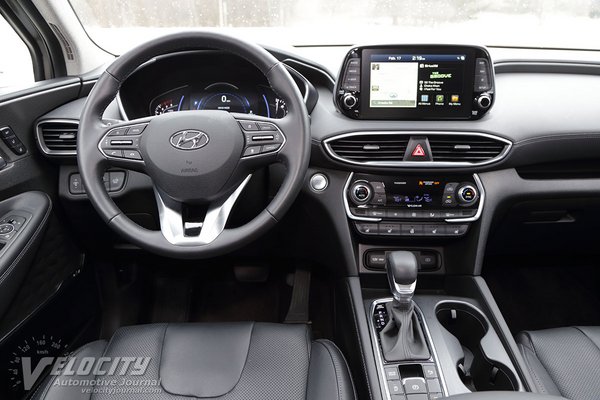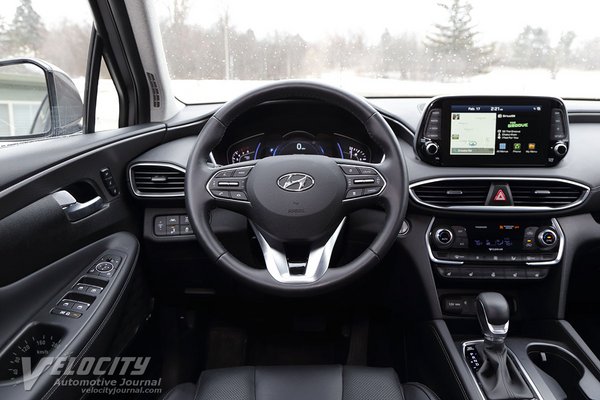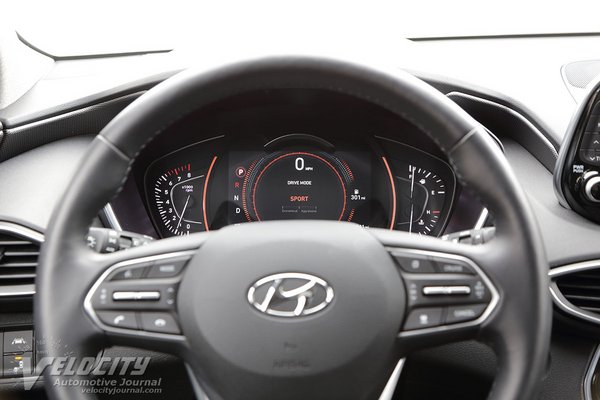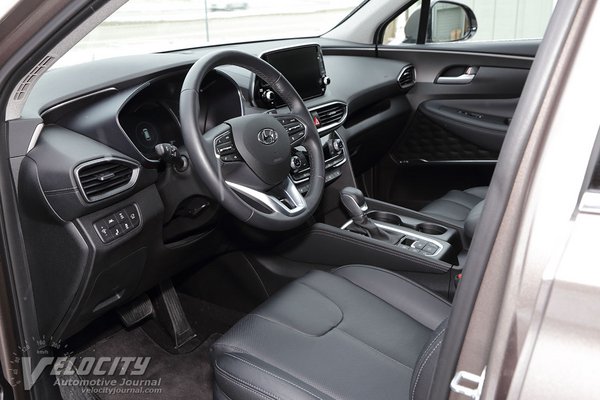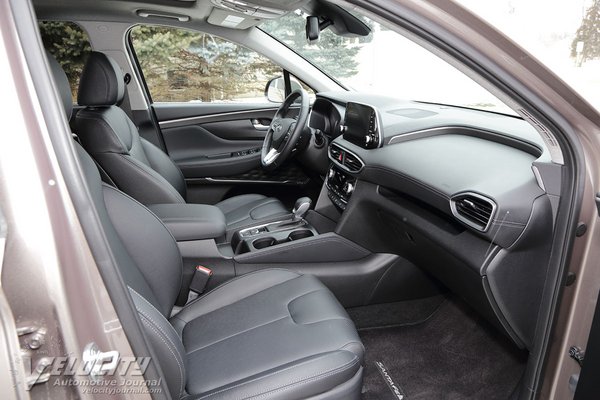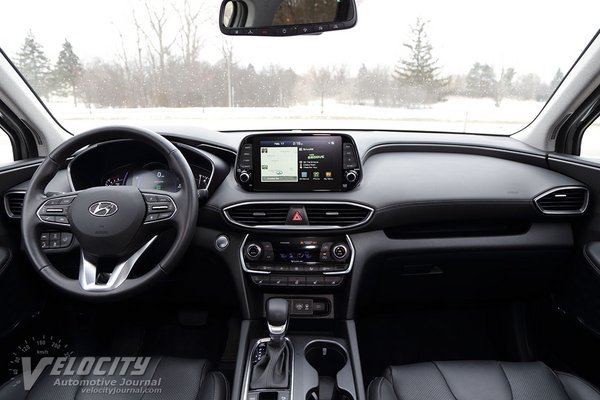2019 Hyundai Santa Fe Ultimate 2.0T
06/30/2019
Shahed Hussain
The Santa Fe has been Hyundai's lineup almost 20 years, and is the best-selling SUV in its lineup. In its fourth generation, the Santa Fe has been completely redesigned for 2019, just in time to take on the new and redesigned midsize SUVs. Hyundai offers seven different trim levels, starting with the Santa Fe SE, SEL, SEL Plus, Limited, Limited 2.0T, Ultimate, and Ultimate 2.0T. Pricing ranges from an affordable $25,750 (SE FWD) to $38,800 (Ultimate AWD). All Santa Fe models are available with optional all-wheel drive ($1,700 extra).
We tested the Santa Fe Ultimate 2.0T AWD equipped with optional floor mats ($125). The total including the freight charge ($980) added up to $39,905. Significant standard equipment includes 19-inch dia. alloy wheels, LED headlights, LED foglights, panoramic sunroof, leather seats, heated/ventilated front seats, heated rear seats, navigation, and Infinity 12-speaker audio system. Safety equipment includes stability control (VSM), forward collision-avoidance assist, blind spot collision warning, lane keeping assist, rear cross-traffic collision warning, and rearview monitor.
Santa Fes are powered by a 2.4L or a 2.0L turbo inline four. Both engines are mated to an 8-speed automatic, which has different gear ratios optimized for each powerplant. The 2.4L is rated at 185 hp @ 6,000 RPM and 178 lb.-ft. @ 4,000 RPM. Only the Limited and Ultimate get the 2.0L turbo, which cranks out 235 hp @ 6,000 RPM and 260 lb.-ft. from 1,450-3500 RPM. The 2.0T is all-aluminum unit with dual overhead cams, direct injection, and continuous variable valve-timing. All-wheel drive 2.0T models have a shorter axle ratio: 3.510 (AWD) vs. 3.320 (FWD) to improve acceleration due to slightly higher curb weight. Curb weight ranges from 4,063-4,085 lbs. for AWD Santa Fes compared to 3,920-3,942 lbs. for FWD models. Fuel consumption is rated at 19/24 MPG (city/hwy.) for the Ultimate 2.0 AWD. Opting for FWD raises both city and highway fuel consumption to 20/25 MPG, respectively.
The Santa Fe uses MacPherson struts and a stabilizer bar in front, complemented with a rear multi-link setup with dampers, coil springs and stabilizer bar. Steering is via a rack-and-pinion setup with electric motor assist and 2.6 turns lock-to-lock. Disc brakes are at all four wheels: 12.6 in. dia. vented rotors in front and 12.0 in. dia. solid rotors at the rear. Ultimate models are shod with 19-in. dia. alloy wheels with 235/55R19 all-season tires. Other Santa Fe variants are equipped with 17-in. dia. or 18-in. dia. alloy wheels.
Hyundai's interior combines plush soft touch plastic surfaces on the dashboard and door trim with hard grained plastic on the lower dash. The perforated leather front seats are comfortable with decent lateral torso support, but the flat thigh bolsters are intended to accommodate a wide range of physiques. Both front seats get power 8-way adjustments, but the driver's seat also includes 4-way lumbar support. Front headroom is adequate for up to 6 ft. tall occupants, but the panoramic sunroof cuts into headroom front and rear. The rear seats provide decent comfort for passengers with above average legroom. The center rear seat position suffers from a hard seatback, and is only acceptable for short trips. Rear headroom is acceptable for people up to 6 ft. tall.
Instead of an analog gauge cluster layout, Hyundai adopted a digital speedometer flanked by a semi-circular tachometer and fuel level and coolant temperature gauges on the opposite side. The leather wrapped steering wheel has integrated phone, audio, and cruise control buttons. Atop the center stack is the 8-in. infotainment touchscreen with knobs for volume and tuning, plus buttons for some audio and navigation functions. Below the center vents are the climate controls and seat heating/ventilation settings. USB and analog audio inputs for portable electronics are located on the center console, as well as a wireless charging pad. Dual cupholders are next to the shift lever. Drive mode, hill descent, and rearview camera controls are clustered behind the shift lever.
As manufacturers are pressed to reduce fuel consumption, normally aspirated sixes are being supplanted by turbo fours, so the 290-hp/252 lb.-ft. 3.3L V-6 has been replaced by a 2.0L turbo four. Despite its higher 260 lb.-ft. peak torque output, the 2.0L suffers from sluggish throttle response below 40 MPH until the turbo spins up. Midrange power is adequate, but acceleration slackens markedly around 80 MPH. Engine noise is isolated from the cabin except at full throttle, when a distant drone is audible. The 8-speed automatic shifts seamlessly even at full throttle, aided by the close ratios between third and eight gears. In Normal mode, the transmission prioritizes higher gears to reduce fuel consumption. Selecting Sport mode alters the transmission shift pattern for better acceleration, although an eighth gear upshift will not occur unless manually selected. We occasionally switched the console shift lever into manual mode for quick downshifts when needed. For most condition, the Smart mode offers the best balance between performance and fuel consumption.
We drove the Santa Fe during the winter in Detroit and found it reassuringly stable on both dry and snow-covered roads. Accelerating on slippery surfaces, the front wheels slip momentarily until the rear axle engages. Initial steering turn-in response is delayed, and accompanied by numb, isolated steering feel. Moderate body roll and understeer communicates that the suspension will not reward pushing the limits. Suspension tuning focused on a compliant ride with good damper control, a difficult task with the 19-inch dia. wheels. Hyundai's chassis engineers were clearly tasked with optimizing the suspension for everyday comfort and long-distance cruising.
The Santa Fe proved to be a competent, but mostly unexceptional midsize SUV. Hyundai does include more standard equipment than most of its competitors, so the Santa Fe is certainly an excellent value. Multiple trim levels ensure that there is a Santa Fe model to fit into most budgets. However, with so many other SUV choices in this segment, it is difficult to recommend the Santa Fe over some of its better-known competitors.

